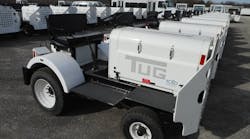Fleet managers are often faced with the difficult task of stretching their budgets while ensuring quality ground support equipment (GSE) is available on the ramp to guarantee efficient turnarounds.
While new GSE units may give operations a boost, refurbishing existing equipment can often provide additional service time without making capital expenditures.
“Depending on the type of GSE, major component replacement can more than double the life of a piece of equipment,” explains Matt Weitzel, regional sales manager at Xcēd. “Due to their less complex design, baggage tractors, for instance, can have their life span doubled simply by replacing an engine and transmission in most cases.”
Terry Bosserman, president of ProFlo Industries, a PrimeFlight company, points out complete zero-time refurbs can reset the lifespan of equipment – comparable to a new unit.
“However, even basic refurbishments can add anywhere from several years all the way to 10 years, depending on the type of equipment and level of refurbishment,” he notes.
Before refurbishments take place, there are considerations that must be weighed to determine how long a piece of equipment can be extended. For example, Weitzel points to environmental factors.
“Replacing an old Ford 300 carbureted engine with the same or similar rebuilt parts and components would not be an option,” he says.
Safety and reliability are the main two factors considered when GSE is being refurbished, explain officials at Mallagahn, which specializes in new GSE but offers refurbishment services to its customers.
“There are a number of reasons it’s determined that a piece of GSE will be refurbished which fall into the categories of health and safety, efficiency and reliability,” say Chris Mallon, spare parts manager at Mallaghan Group, and Ryan McElhone, head of customer care at Mallaghan Group.
“Mallaghan’s customer care department offers various practical and economical ‘machine upgrade and modification’ solutions, which entails safety upgrades such as IATA AHM913 collision avoidance system retrofits, vehicle refurbishments, accident repairs and vehicle paintings.”
Refurb Candidates
Although certain cases may have special requirements, essentially any piece of GSE can be refurbished. Common examples include baggage tractors and belt-loaders, pre-conditioned air (PCA) and heater units, ground power units (GPUs), baggage carts, tow-bars and lavatory/water carts.
“Throughout the PrimeFlight network of companies, we have the capabilities to refurbish a wide range of equipment. Our ProFlo Industries team mostly works to refurbish aircraft refueling equipment, including Avgas and jet refuelers, hydrant dispensers, rampservicers and towable hydrant carts, while PrimeFlight GSE Maintenance also refurbishes powered GSE such as tugs, pushbacks, belt-loaders, deicers and lav trucks,” Bosserman says, noting the most difficult equipment to refurbish is equipment that has little to no parts support due to its age. “In addition, ProFlo LATAM refurbishes a full line of refueling and GSE equipment within the free-trade zone of Colombia, South America.”
Smaller GSE units are also candidates for refurbishment, according to Chantel Donaldson, lead technician at Ramp Communications.
Donaldson points out every part of pushback, deicing, maintenance and wireless headsets can be easily refurbished, including headset accessory items like belt stations, extension cords and Y-adapters.
“Headsets are almost infinitely repairable,” Donaldson says. “The lifespan of repaired units is dependent on handling, maintenance and use of OEM parts. We frequently see equipment that is 15 to 20 years old that has had regular maintenance.”
For larger equipment, Weitzel says most major components can be refurbished, depending on the capabilities of the GSE maintenance shop.
“Typically, engines, transmissions, axles, pumps and motors are all great candidates for refurbishment as the cost of a new unit far exceeds the cost of a rebuilt one,” he says. “Specialty shops with the experience and capabilities to rebuild/refurbish most components offer ‘like-new’ parts and components for a fraction of what brand new would cost.”
At Mallaghan, drive trains of self-propelled GSE on equipment like the Bendibelt cargo and baggage conveyor belt, passenger stairs and medical lifts can be refurbished most effectively.
“The more complex the equipment or damage, the more complex the refurb or repair. The majority of our GSE portfolio can be upgraded, modified and/or refurbished,” Mallon and McElhone say, adding anywhere from 3 to 15 years can be added to the equipment’s lifespan, depending on the level of refurbishment.
With varying degrees of refurbishment available, including light, medium and heavy refurbs, deciding when to refurb a GSE unit comes down to making the best economical decision for any given operation.
“We evaluate the type of equipment, parts availability and estimated cost to refurbish,” explains Bosserman. “We like to target about 60-75% of the cost of a new piece of GSE for a guideline as to whether it makes sense to refurbish or not.”
Mallaghan officials note if equipment is more than 50% through its lifespan, and the cost of one repair is more than 50% of the cost of buying new, customers may want to consider replacing the unit rather than opting for refurbishment.
“Nevertheless, it depends very much on the equipment type and customer need,” Mallon and McElhone add. “Generally, the viability of refurbishments jobs are properly checked by the Mallaghan customer care team in cooperation with the customer.”
Most refurbishments for headsets are cost-effective, even in extreme cases where headsets are run over or cords have severed.
“Less than 2% of equipment failures are beyond economical repair,” says Donaldson, basing this figure on what comes to Ramp Communication’s facility for repair. “Without the proper test equipment, it can be difficult for end-users to determine when a headset is cost-effective to repair.”
Each company is different and has its own financial goals and metrics, Weitzel adds, but the decision comes down to a few basic factors. How much is this specific piece of equipment costing in maintenance each month? What are the forecasted costs going to be? How much will refurbishment cost, and will refurbishment save the required costs when completed?
“The answers to those questions would then be compared to the cost of a new unit,” Weitzel says. “From there, the company would determine if its budget can support the decision or does the company want to spend Capex on GSE, which is the biggest determining factor post-COVID.”
The Refurb Process
Bosserman says the first step of the refurbishment process is a complete initial inspection. That is followed by an engineering review with drawings and a bill of materials.
“Once this is complete, we work through the process of purchasing, production scheduling, stripping down the equipment and refurbishing it,” he says, adding the entire process can take between two to six weeks depending on the level of refurbishment and modifications being performed.
“Once the refurbishment is complete, we test and prep it for shipment.”
Weitzel says the initial inspection helps determine what level of refurbishment is necessary.
“Many times, a basic refreshment of the unit is all that is required, particularly for units with lower hours,” he notes. “If, however, a more extensive refurbishment is required, such as updating the power train with a more efficient configuration, the process will be more in-depth.”
What’s more, there are some shops that specialize in zero-time kits containing all necessary components to perform a refurbishment. These kits are designed to bolt right in, but there can still be modifications and other fabrication required for the installation to be successful.
During the process, Weitzel also notes units are stripped of all rust and paint by media blasting.
“Then all required fabrication can be completed. This is when test fitting and mockups should happen to ensure all body panels can be refitted to the unit,” Weitzel says. “Once the fabrication, paint prep and test fitting are complete, the unit can be sent off to paint, where the frame, suspension, axles and all other components requiring paint can be finished.
“After paint, the unit can be reassembled,” he continues. “Upon completion of the refurbishment process, the unit will need to undergo extensive testing to ensure it will perform as intended. After the testing is completed, then the unit can be returned to the operation.
“The length of time it takes for a GSE unit to complete the refurb process depends on the refurbishment required, the process is always delivered in a timely manner,” add Mallon and McElhone.
Headset repairs are treated similarly, beginning with a cleaning, inspection and electrical testing.
“Once all problems are identified, a cost analysis is performed to determine if the unit is economical to repair. Damaged parts are removed and replaced with genuine OEM components,” Donaldson says.
Preventative maintenance is also performed during the process.
“For example, if a plug is close to failure or cords show advanced wear, they are replaced. Performing preventive maintenance while units are in the shop for repair reduces out-of-service time and cost to customers over the unit's lifespan,” Donaldson says, adding headsets can take between 15 and 60 minutes to be refurbed, depending on their condition. “A failed microphone takes very little time. A headset with advanced wear, water damage and intermittent components requires much more time to diagnose and restore to factory specifications.”
Parts availability, shop workload and upgrade requirements can impact the time required for any refurb project. Weitzel notes that newly exacerbated supply chain problems for many parts and components have been created by the COVID-19 pandemic.
If a unit is being repowered or converted to an electric power train, Bosserman says the refurbishment timeline can be extended by several weeks or more.
Weitzel says it’s worth noting, however, that OEMs are currently working on drop-in packages for converting older GSE to electric units.
“But they are not as readily available as traditional internal combustion power train conversions or upgrades,” Weitzel says. “In time, the drop-in kits will catch up as momentum for zero emission GSE grows.”
If done correctly, refurbished equipment requires no additional maintenance.
“There would be no additional maintenance requirements other than updating the maintenance schedules and manuals to reflect the difference in the engine/transmission configurations,” Weitzel says.
“We treat refurbished equipment the same way we would treat new equipment,” agrees Bosserman.
“Care for refurbished headsets and accessories is no different from when they left the factory,” Donaldson adds. “We suggest regular cleaning and inspection of all equipment to extend its' lifespan.”
Mallon and McElhone say that following any refurbishment at Mallaghan, a piece of GSE undergoes the same rigorous testing as required for new equipment, to ensure it’s fit to return to service.
Additional Considerations
Refurbished GSE can solve many challenges faced by a ground handling operation. However, Donaldson notes that smaller, more frequent refurb projects can reduce out-of-equipment condition.
“Airlines should not wait until they are short on working headsets before sending them in to be repaired,” she says.
The refurb process is an advantageous time to evaluate potential upgrades to equipment.
“This could range from ensuring equipment meets all current standards to taking the opportunity to perform new technology upgrades,” Bosserman says.
The skill level of the GSE mechanics is also a key factor, advises Weitzel.
“The global pandemic placed many highly skilled people out of work. Many have moved on to different career paths, which leaves a skill and experience vacuum in the industry,” he says, adding Xcēd is fortunate in that the company did not have to furlough any employees during the economic downturn. “This will temporarily impact refurbishments until those positions can be filled. Refurbishments are time-consuming and do not always go as smoothly as planned, so having highly skilled individuals is essential for success.”






